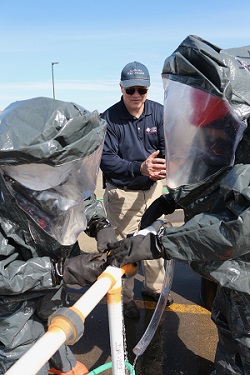
Impact on Worker and Public Health
Work is a social determinant of health – this means that the conditions in which people work influence their health and shape their daily lives. The NIEHS Worker Training Program (WTP) is committed to improving the health and well-being of workers and ensuring that workplace conditions are safe.
Since 1987, WTP has trained more than 5 million workers in the U.S. and surrounding territories, providing them with proper training and education, and empowering them with knowledge and skills to safely handle or remove hazardous materials.
As of 2022, the U.S. workforce includes nearly 200 million people, and this number is projected to grow rapidly by 2030. Compared to past decades, many people are entering the workforce at a younger age. In addition, many immigrants travel to the U.S. seeking seasonal or permanent employment. These factors often change based on the economy, weather-related events, or public health emergencies.
Regardless of the circumstances, WTP helps ensure that workers across various ages, ethnicities, and occupational sectors have access to training and resources to protect themselves, their colleagues, and communities from harmful exposures. WTP demonstrated this commitment recently during the coronavirus 2019 (COVID-19) pandemic. The program had a swift response to the pandemic (3MB) during social distancing and other restrictions and delivered in-person and online training courses to essential workers in health care, transportation, and other industries.
Network of Nonprofit Organizations
WTP funds a network of nonprofit organizations that deliver high-quality, evidence-based safety and health training across the U.S. and surrounding territories. These organizations include labor-based health and safety organizations and academic institutions who are committed to protecting the safety, health, and well-being of workers and their communities.
WTP award recipients were originally charged with developing safety and health training for workers engaged in specific activities related to hazardous materials and waste generation, removal, containment, transportation, and emergency response. Today, these organizations train workers in all types of workplace settings, including healthcare, agriculture, manufacturing, construction, and more. Training opportunities reach young and older workers, and range from full-time, permanent workers to migrant and temporary workers.
WTP award recipients give workers and their employers access to reliable tools, content, curricula, resources, web- and classroom-based materials. Training is delivered under the following program areas:
- Hazardous Waste Worker Training Program
- Environmental Career Worker Training Program
- Hazardous Materials (HAZMAT) Disaster Preparedness Training Program
- SBIR E-Learning for HAZMAT Program
- NIEHS/U.S. Department of Energy (DOE) Nuclear Worker Training Program
- Infectious Disease and Biological Hazards Training
Focus on All Hazards
WTP uses an all-hazards approach for training. This means that training covers existing, emerging, and unknown threats, as well as disaster-specific hazards. For example, while the risks of exposure to lead and asbestos are well known, the risks associated with other hazards like lithium-ion batteries are emerging and still being explored. Infectious disease variants are also an emerging concern as scientists uncover molecular signatures and determine the risk of transmission. Natural disasters like floods, wildfires, and hurricanes are occurring more frequently, and manmade disasters are a growing concern as the production and transport of hazardous materials continues to expand in different regions.
The all-hazards approach is crucial because it aims to cover all conditions and environments that workers may face. Training curricula and resources are needed to ensure the safety of workers and communities. WTP supports training and development of curricula that help employers meet federal standards mandated by the Occupational Safety and Health Administration (OSHA) and the U.S. Environmental Protection Agency (EPA). This includes, but is not limited to, OSHA’s Hazardous Waste Operations and Emergency Response (HAZWOPER) standard and EPA’s standards for hazardous waste operations and emergency response.
Reach Various Industries
WTP delivers training to a variety of workers who face the risk of injury or illness due to exposure to hazardous work environments. Training is delivered to workers across many occupational sectors, including those involved in construction, disaster response and cleanup, health care, agriculture, chemical and manufacturing facilities, transportation, and more.
Resources for the Health and Safety Community
WTP also funds the National Clearinghouse for Worker Safety and Health Training, a national resource for worker curricula, technical reports, and weekly news on hazardous materials, waste operations, emergency response, and ongoing workplace hazards and controls. The National Clearinghouse supports the efforts of WTP staff and award recipients in providing health and safety training to workers engaged in activities related to hazardous materials and waste generation, removal, containment, transportation, and emergency response.


